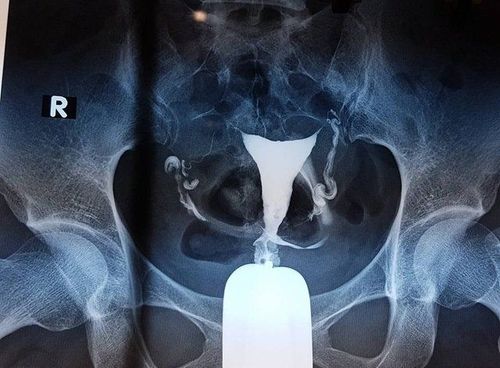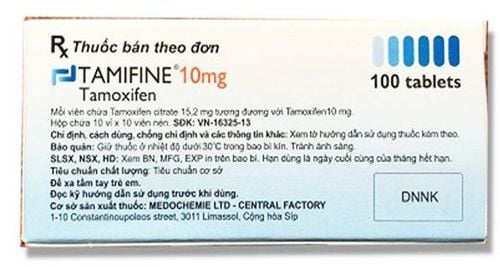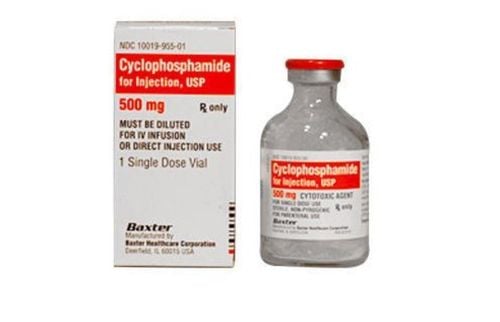This is an automatically translated article.
The article is professionally consulted by Master, Doctor Ton Nu Tra My - Department of Diagnostic Imaging - Vinmec Central Park International General Hospital.Contrast-enhanced hysterosalpingogram is a technique used to diagnose some causes of infertility (infertility, difficulty having children) related to the uterus and/or fallopian tubes.
1. What is a hysterosalpingogram?
Hysterosalpingography (HSG) is an imaging test that helps to look inside the uterus and fallopian tubes (fallopian tubes, fallopian tubes).In this method, contrast dye is injected through the cervix with low pressure. Because the uterus and fallopian tubes are connected, the contrast medium will flow into both the uterus and fallopian tubes. Then, taking X-ray films of the uterus and fallopian tubes, the doctor will see images of the uterus and fallopian tubes, detect abnormalities in the cervix, uterus and fallopian tubes on both sides.
Some abnormal images after X-ray of the uterus and fallopian tubes can be observed and detected such as: uterine adhesions, uterine malformations, dilated fallopian tubes, blocked fallopian tubes... or some diseases in the uterine cavity such as uterine fibroids, uterine polyps.
This technique helps to accurately diagnose some of the abnormalities that lead to infertility and can also help treat this condition. In addition, after tubal ligation, to make sure these tubes are completely closed, the doctor may order the patient to have a hysterosalpingogram using contrast.

2. Indications and contraindications of hysterosalpingogram
Hysterosalpingogram is usually indicated in the following pathologies:Diagnosis of primary and secondary infertility caused by tubal obstruction; Testing and evaluation of intrauterine contraceptive devices; Diagnosis of endometriosis or endometriosis; Abnormal problems inside and outside the uterus and tumors. X-ray of the uterus and fallopian tubes is contraindicated in the following cases:
Pregnant women; Untreated and controlled pelvic infections; Heavy bleeding in the uterus when performing this method

3. When is the best time to have an X-ray of the uterus and fallopian tubes?
The best time to have an X-ray of the uterus and fallopian tubes is from the 7th to the 10th day of the menstrual cycle, with the first day being interpreted as the first day of the last menstrual period. Besides, before taking an X-ray of the uterus and fallopian tubes with contrast injection, it is necessary to note some of the following issues:Depending on the case, the doctor can use prophylactic antibiotics before taking the scan. Abstain from sex before having an X-ray of the uterus and fallopian tubes. Patients need to have a gynecological examination, test for chlamydia, fresh vaginal discharge, blood test, and full abdominal ultrasound before performing a hysterosalpingogram. After completing the X-ray of the uterus and fallopian tubes, the patient will be asked to stay in the hospital for 30 - 45 minutes for observation. In case of abnormal signs, it is necessary to detect them early so that they can be treated promptly.

4. Some abnormalities may occur after an X-ray of the uterus and fallopian tubes
After an HSG scan, you may experience some vaginal discharge from the contrast fluid injected through the cervix during this procedure, sometimes with little blood. This phenomenon is not serious, women just need to use tampons to absorb this fluid. Note do not use tampons.In addition, the patient may experience the following symptoms after taking an X-ray of the uterus and fallopian tubes such as:
Light vaginal bleeding; Muscle cramps; Dizziness, lightheadedness; Stomachache; The patient may faint. Are X-rays of the uterus and fallopian tubes harmful? Statistically, the risks after the scan are very rare. Some complications that have occurred include: pelvic inflammatory disease, uterine trauma, or an allergy to iodinated contrast. If the patient after HSG scan and has the following symptoms, they should immediately notify the doctor:
Nausea or vomiting; Fainting; Vaginal discharge with an unpleasant odor; Severe cramps; Heavy vaginal bleeding; Fever, abdominal pain or chills. Vinmec International General Hospital with a system of modern facilities, medical equipment and a team of experts and doctors with many years of experience in medical examination and treatment, patients can rest assured to visit. and hospital treatment.
Please dial HOTLINE for more information or register for an appointment HERE. Download MyVinmec app to make appointments faster and to manage your bookings easily.
MORE
X-ray of the uterus and fallopian tubes (HSG) in which case? Why is it difficult to get pregnant, so an X-ray of the uterus and fallopian tubes should be taken? What is the purpose of an X-ray of the uterus and fallopian tubes?














